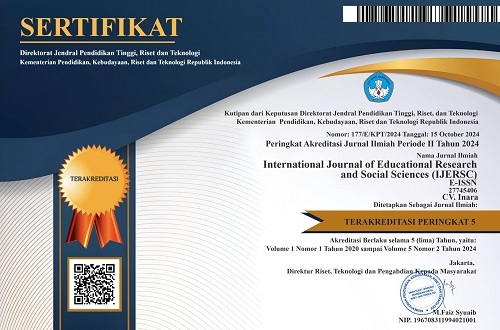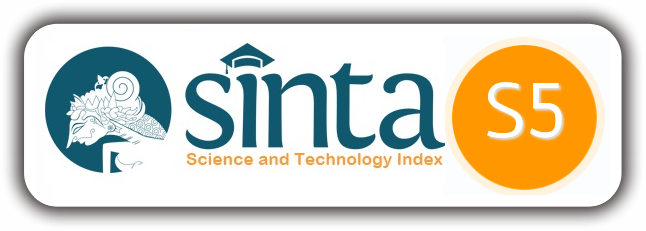Cultural Tourism Development Strategy at The Siak Palace, Siak Sri Indrapura Regency
DOI:
https://doi.org/10.51601/ijersc.v6i5.1001Abstract
Riau is a province rich in history. Many historical heritage buildings can be found in Riau, one of which is the Siak Sri Indrapura Palace. This palace is a historical legacy of the Siak Sultanate, once inhabited by the Sultan of Siak, and today serves as one of the tourism attractions in Siak Regency. The proper development of the tourism sector has the potential to attract both domestic and international tourists to visit and spend money during their travels. In this context, particularly concerning the development of the Siak Palace as a tourist attraction, internal and external environmental analyses are conducted to identify strengths, weaknesses, opportunities, and threats through a SWOT analysis. Furthermore, this study also examines the long-term goals of the Tourism Office, particularly in achieving its mission over the next five years. The research evaluates whether the strategies implemented have been successful by reviewing the annual targets set by the Siak Regency Tourism Office and the policies employed to achieve them. These policies consist of guidelines, rules, and procedures established to support the intended objectives. The findings indicate that the Tourism Office of Siak Regency has carried out the strategic planning process effectively. Every aspect of strategic planning has been implemented optimally and in accordance with the established regulations. However, despite the successful implementation of the strategic plan, the process has not yet fully maximized the development of the Siak Palace as a tourism destination, as further actions beyond the current plans are still required. Tourism development in Siak Sri Indrapura is pursued through the development of tourism resources and the creative economy, enhancement of tourist attractions, and tourism marketing. Nevertheless, these efforts have not yet been fully optimized and therefore need improvement in order to better manage and advance tourism development in Siak Regency. The factors influencing tourism development strategies include budget, human resources, and community participation. Successful tourism development requires cooperation to achieve the desired outcomes, while the government is also expected to pay greater attention to the condition of tourism objects.
Downloads
References
Agus Maulana. (2014). Management Control System. Jakarta: Salemba Empat.
Cindi Shandoval & Daud Aris Tanudirjo. (2018). Management of Siak Palace as a Museum (Undergraduate Thesis in Archaeology, UGM). Focuses on the physical condition of the building and collection, as well as museum management proposals: vision–mission, collection governance, human resources, and partnerships.
Department of Culture and Tourism. (2008). Final Report on the Follow-Up Study of Tourism Attraction Assessment. Collaboration between the Directorate of Tourism Products, Directorate General of Tourism Destination Development, Department of Culture and Tourism and Innovative Development for Eco Awareness. Jakarta.
Fandeli, C. (2002). Nature Tourism Planning. Yogyakarta: Faculty of Forestry, Universitas Gadjah Mada.
Fandeli, C., & Mukhlisin. (2004). Ecotourism Development Policy: Ecotourism Development with a New Paradigm of Conservation Area Management. Faculty of Forestry, UGM. Yogyakarta: UKSDA Jogja and Pustaka Pelajar.
Ife, J., & Frank, T. (2008). Community Development: An Alternative Approach to Community Development in the Era of Globalization (3rd ed., Translated). Yogyakarta: Pustaka Pelajar.
Indonesian Ecotourism Network (INDECON). (2008). Draft Standardization of Community-Based Ecotourism (CBT) Development. Paper presented at the Tourism Convention, in collaboration with ECEAT (European Centre for Ecotourism and Agricultural Tourism) and INDECON, Nusa Dua, Bali, March 13–16, 2008. “Creating a Community-Based Tourism Supply Chain in South and East Asia.”
Romani, S. (2006). Assessment of Natural Tourism Objects and Attractions and Alternative Planning in Bukit Duabelas National Park, Jambi Province (Undergraduate Thesis). Department of Forest Resource Conservation and Ecotourism, Faculty of Forestry, Bogor Agricultural University.
Suwantoro, G. (2003). Fundamentals of Tourism. Yogyakarta: ANDI.
World Tourism Organization (WTO). (2004). Indicators of Sustainable Development for Tourism Destinations: A Guidebook.
Yoeti, O. A. (2008). Tourism Economics: Introduction, Information, and Implementation. Jakarta: Kompas.
Tobing, Luis Volmasi. (2020). Tourism Office Strategy of Riau Province in Increasing Tourist Visits in Riau Province. Undergraduate Thesis, State Islamic University of Sultan Syarif Kasim Riau.
Wiyati, B. T. K. (2018). Tourism Development Strategy in Lumajang Regency (Study on Puncak B29 Tourist Attraction in Argosari Village, Senduro District, Lumajang Regency).
Downloads
Published
How to Cite
Issue
Section
License
Copyright (c) 2025 International Journal of Educational Research & Social Sciences

This work is licensed under a Creative Commons Attribution 4.0 International License.






















